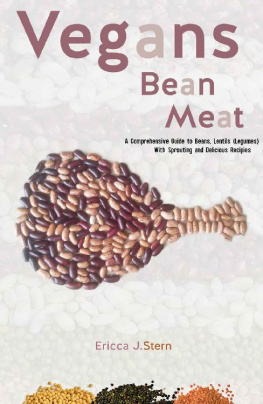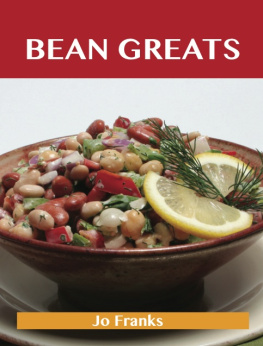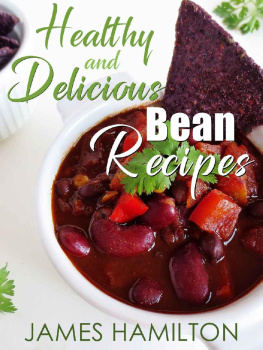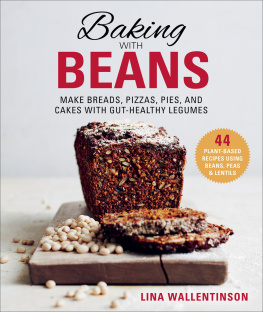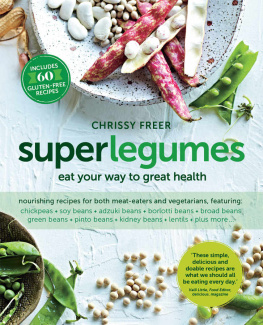2018. All rights reserved.
All rights reserved. No portion of this book
written consent from the author.
Summary
Phaseolus spp. Is the scientific name that encompasses different varieties of the leguminous and proteinous food - beans; a very affordable, versatile and nutritious food crop that has retained its position as a dietary staple since time immemorial. Inexplicably, beans are foods whose nutritional benefits and overall contributions to general health and wellbeing have often been underrated and downplayed, with the role the legume played as the ideal substitute for meat during The Great Depression being implicated as the sole reason behind its association with the now infamous epithet: poor mans meat - a scarcely-merited label that has seen the food disappears from the lavish seven-course menus in the banquets of the affluent, whilst becoming central to the masses meals. But this work seeks to inspire a return to the basics, an address of the common misconceptions.
The purpose of this work is to put beans back on the dietary map on the dietary map as the ultimate dietary staple. It starts by tracing the dietary significance and economic importance of beans from the earliest of times - way before there was ever an organized body of knowledge that has now come to be known as nutrition and dietetics in more recent times. This historical perspective of beans importance gives insight, provides precedent, and sets the tone for the rest of the work.
The succeeding parts of this book broadly highlight the nutrient content and nutritional importance of beans. The spotlight is placed on beans importance as a veritable and ample source of nutrients that are vital to bodily functions and metabolism. Such nutrients as proteins, carbohydrates, dietary fiber, vitamins, and minerals are contained in sufficient amounts in the legume. Also highlighted is the food crops richness in folates; a nutrient necessary for the proper neural development of the foetus during pregnancy, which makes it a very important food for expectant mothers. And it gets even better with the fact that all these nutritional benefits are in the offing with very little or nothing offered in the way of saturated fats and bad cholesterol - substances harmful to the body when present in high amounts.
The later parts of this work are dominated by the chemical composition of beans, a tabulated nutritional formulation of some selected species, as well as examples of some varieties that are nutritious. There is also a well-explained description of the dietary importance of beans and its implications on people's health and wellbeing.
When incorporated as a key part of daily diet, beans is known to bring about such health benefits as regulating blood sugar levels, curtailing hypercholesterolemia, maintaining healthy functioning of the heart, controlling weight and appetite, remedying diabetics, reducing susceptibility to cancers, maintaining a healthy gut and preventing fatty liver condition, amongst other important health benefits.
What better way to come to a climax than draw the curtain on a mouth-watering note with an expose into some exquisite beans recipes? The versatility of beans is such that it seamlessly fits into a number of recipes cutting across main dish, side dish, appetizer, snack, and even baked goods recipes. Beans offer the luxury of both healthy and tasty in one fell scoop - thats two for the price of one. And how often are we afforded such a luxury on a platter? It really doesnt get better than beans!
Introduction
What sets beans apart from other food crops? Structurally, they have pods with seeds inside them. Apart from beans, they also include peas, lentils and peanuts are even added to this category in some quarters. Beans are often classified as legumes, even though a less expansive view reserves the word for leguminous crops harvested for their dry grain. The term bean typically excludes legumes with tiny seeds which exclusively serve forage purposes, hay and silage purposes such as clover and alfalfa.
After contact between Europe and the Americas in the Colombian era, the term beans was extended to include pod-borne seeds such as the common bean, the runner bean, and the related genus Vigna. It is also common to have the term being applied to many other seeds of similar form, including the Old World favorites such as soybeans, peas, chickpeas, vetches, and lupins. Those with even less resemblance or association such as coffee beans, vanilla beans, castor beans and cocoa beans are also referred to by the same term because of their similar form. This explains why the term bean is loosely used to make reference to a whole lot of different species.
In the same manner as the early grains, legumes make up one of the first crops ever cultivated, dating as far back as the Bronze Age. Both archaeologists and Paleontologists alike have discovered beans in the tombs of the Pharaohs and Aztecs. They were revered as an emblem of life in ancient Egypt - even having entire temples dedicated to them. The Greeks and the Romans were not left out too as it was used in festivals to worship gods. Throw that in with the fact that the four most prominent families of the Roman era get their names from beans species - Fabiu s (Fava bean), Lentulus (lentils), Piso (pea) and Cicero (chickpea) - and you will understand just how far this crop comes.
Early discoveries point to the fact that Indians, who are known to have spread across the Americas, cultivated and consumed numerous kinds of beans. From the earliest of times, beans were traded back and forth, planted and consumed, as explorers wandered the earth. During the Middle Ages, beans formed one of the primary foods of the peasants of Europe.
A return from memory lane and to more recent times show that beans also came in handy for sailors due to its ease of storage and availability - this should come to mind whenever you think about how Navy bean got its name. The food has fed great armies of the world from the most primitive of times to the battles of the recent past. From a period that came to be known as the Great Depression right up to todays world, beans have remained steadfast in its offering of a tasty appeal and high nutritional value. A single cup of cooked beans supplies an astonishing 25% of the Recommended Daily Allowance (RDA) for amino acids at a cost lesser than the requirement for meat production. Such figures as this are what makes beans indispensable as a staple in todays pantries. This work seeks to address the apparent dearth of information resources and limited literature on the subject of the seed crop; beans, as well as its undisputed importance since the beginning of time, its relatively superior nutritional advantages and some of its exquisite, tasty and mouth-watering recipes.
Beans are one of the longest cultivated plants. Broad beans, also called Fava beans, in their wild state the size of a small fingernail, were gathered in Afghanistan and the Himalayan foothills.
BEANS AND ITS IMPORTANCE FROM THE EARLY TIMES

A Selective History of Beans
Phaseolus spp. That s what this wonderful legume is called in scientific circles these days. But long before we ever got to grips with taxonomy and its nuances, and way before scientific classifications and nomenclature became a thing, this vital crop has been the centerpiece of a great many civilizations.

